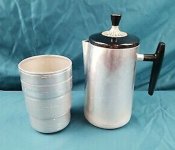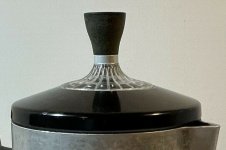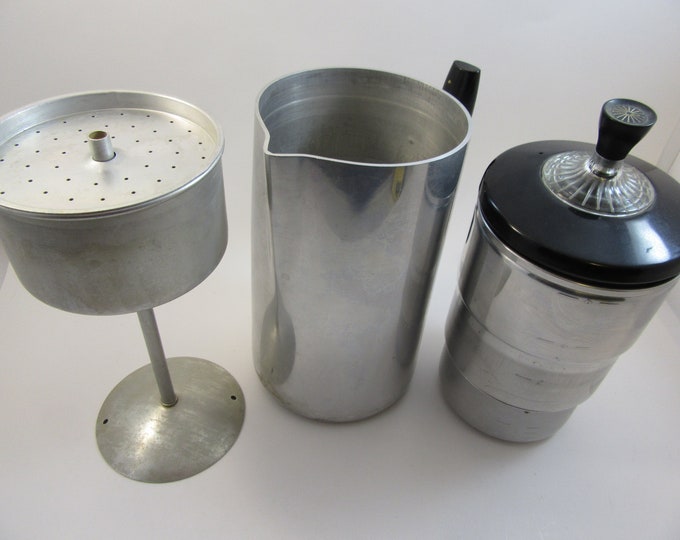Upvote
12
Navigation
Install the app
How to install the app on iOS
Follow along with the video below to see how to install our site as a web app on your home screen.
Note: This feature may not be available in some browsers.
More options
You are using an out of date browser. It may not display this or other websites correctly.
You should upgrade or use an alternative browser.
You should upgrade or use an alternative browser.
I found this Coffee pot
- Thread starter flyadive
- Start date
- Aug 19, 2014
- 38,264
- 139,048
- Detector(s) used
- JW 8X-ML X2-VP 585
- Primary Interest:
- All Treasure Hunting
Yes... your are missing something....
The coffee.
:P
The coffee.
:P

- Thread starter
- #6
Everything is on the tableCool...would you consider making this the prize for your "New Contest" thread?
villagenut
Gold Member
The younger generation would say......"that ain't no coffee pot, there is no cord on it" 

AU Seeker
Bronze Member
- Oct 14, 2007
- 1,408
- 1,165
- Detector(s) used
- E-Track, MXT, CZ6A
- Primary Interest:
- All Treasure Hunting
I don't think it's a coffee percolator because there's no spout and all the ones I saw growing up didn't have that many "levels", if it is a percolator it would be at least missing the "basket", all the ones from when I was growing up had a basket on a tube, you put the coffee grounds in the basket and when the water started boiling the water would go up the tube and out into the basket draining through the coffee grounds, the "percolating" noise was when the water came out the tube in spurts making the noise which could be seen in the glass portion of the lid.
What it look more like to me is a small "double boiler", you put water in the lower section and stuff like chocolate or cheese in the upper section to heat/melt it without burning it, it's also used for making delicate sauces which burn easily, albeit all double boilers I have seen have handles for each section which this doesn't have.
What it look more like to me is a small "double boiler", you put water in the lower section and stuff like chocolate or cheese in the upper section to heat/melt it without burning it, it's also used for making delicate sauces which burn easily, albeit all double boilers I have seen have handles for each section which this doesn't have.
Last edited:
Nice!!! Congrats!!!View attachment 2034977View attachment 2034976View attachment 2034975View attachment 2034973View attachment 2034974I found what I think is a coffee percolator in an old one room school house in Pa. It holds 4 cups water although it says 6? Anyone ever seen one of these and I think it’s missing something?
- Dec 30, 2012
- 8,414
- 15,958
- 🏆 Honorable Mentions:
- 2
- Detector(s) used
- Presently using Deus 2's & have Minelabs, Nokta's Tesoro's DEus's Have them all . Have WAY to many need to get rid of some
- Primary Interest:
- All Treasure Hunting
Seems like there should be a STRAINER cap that goes over the Coffee holder
- Feb 3, 2009
- 41,373
- 158,390
- 🥇 Banner finds
- 1
- Detector(s) used
- Deus, Deus 2, Minelab 3030, E-Trac,
- Primary Interest:
- Relic Hunting
The second photo shows there's holes in the bottom of the large unit as well.I don't think it's a coffee percolator because there's no spout and all the ones I saw growing up didn't have that many "levels", if it is a percolator it would be at least missing the "basket", all the ones from when I was growing up had a basket on a tube, you put the coffee grounds in the basket and when the water started boiling the water would go up the tube and out into the basket draining through the coffee grounds, the "percolating" noise was when the water came out the tube in spurts making the noise which could be seen in the glass portion of the lid.
What it look more like to me is a small "double boiler", you put water in the lower section and stuff like chocolate or cheese in the upper section to heat/melt it without burning it, it's also used for making delicate sauces which burn easily, albeit all double boilers I have seen have handles for each section which this doesn't have.
It's an insert for another unit for sure.
bc5391
Hero Member
- Sep 23, 2016
- 636
- 953
- Detector(s) used
- Minelab ,XP
- Primary Interest:
- All Treasure Hunting
still have one in my RV, coffee smells and tastes better than those that have cords
DigToChina
Bronze Member
Think AU is right. I’d think the part with holes is the steamer component.I don't think it's a coffee percolator because there's no spout and all the ones I saw growing up didn't have that many "levels", if it is a percolator it would be at least missing the "basket", all the ones from when I was growing up had a basket on a tube, you put the coffee grounds in the basket and when the water started boiling the water would go up the tube and out into the basket draining through the coffee grounds, the "percolating" noise was when the water came out the tube in spurts making the noise which could be seen in the glass portion of the lid.
What it look more like to me is a small "double boiler", you put water in the lower section and stuff like chocolate or cheese in the upper section to heat/melt it without burning it, it's also used for making delicate sauces which burn easily, albeit all double boilers I have seen have handles for each section which this doesn't have.
Red-Coat
Gold Member
What you have there are the ‘Drip-o-Lator” parts from a vintage “WearEver” stovetop coffee set. I believe it’s model #968, sold as a seven-piece set until the 1950s, comprising Percolator/Drip-O-Lator/Coffee Pot. The lid fitted the Drip-O-Lator as well as the pot, but only the pot itself had a handle and drip-spout.
I think you’ll find the lid is an exact match:


“WearEver” cookware was launched in 1903 as a vehicle to promote the use of aluminium in new markets by the Aluminum Company of America (ALCOA). [Note English spelling of aluminium and that there is no such substance as “aloominum” outside America ]. Initially sold door-to-door by college students and then as direct-to-customer-delivery. The use of a Phillips head screw to secure the finial on the lid puts it no earlier than the second half of the 1930s.
]. Initially sold door-to-door by college students and then as direct-to-customer-delivery. The use of a Phillips head screw to secure the finial on the lid puts it no earlier than the second half of the 1930s.
I think you’ll find the lid is an exact match:


“WearEver” cookware was launched in 1903 as a vehicle to promote the use of aluminium in new markets by the Aluminum Company of America (ALCOA). [Note English spelling of aluminium and that there is no such substance as “aloominum” outside America
 ]. Initially sold door-to-door by college students and then as direct-to-customer-delivery. The use of a Phillips head screw to secure the finial on the lid puts it no earlier than the second half of the 1930s.
]. Initially sold door-to-door by college students and then as direct-to-customer-delivery. The use of a Phillips head screw to secure the finial on the lid puts it no earlier than the second half of the 1930s.AU Seeker
Bronze Member
- Oct 14, 2007
- 1,408
- 1,165
- Detector(s) used
- E-Track, MXT, CZ6A
- Primary Interest:
- All Treasure Hunting
Red-Coat nailed it, here's a photo showing the "basket/strainer/tube" part that I mentioned in my previous reply.What you have there are the ‘Drip-o-Lator” parts from a vintage “WearEver” stovetop coffee set. I believe it’s model #968, sold as a seven-piece set until the 1950s, comprising Percolator/Drip-O-Lator/Coffee Pot. The lid fitted the Drip-O-Lator as well as the pot, but only the pot itself had a handle and drip-spout.
I think you’ll find the lid is an exact match:
View attachment 2035209 View attachment 2035210
“WearEver” cookware was launched in 1903 as a vehicle to promote the use of aluminium in new markets by the Aluminum Company of America (ALCOA). [Note English spelling of aluminium and that there is no such substance as “aloominum” outside America]. Initially sold door-to-door by college students and then as direct-to-customer-delivery. The use of a Phillips head screw to secure the finial on the lid puts it no earlier than the second half of the 1930s.

DigToChina
Bronze Member
RC for the win yet again!
just one thing remains: The conundrum over why it measures out as only 4 cups but "says" 6.What you have there are the ‘Drip-o-Lator” parts from a vintage “WearEver” stovetop coffee set. I believe it’s model #968, sold as a seven-piece set until the 1950s, comprising Percolator/Drip-O-Lator/Coffee Pot. The lid fitted the Drip-O-Lator as well as the pot, but only the pot itself had a handle and drip-spout.
I think you’ll find the lid is an exact match:
View attachment 2035209 View attachment 2035210
“WearEver” cookware was launched in 1903 as a vehicle to promote the use of aluminium in new markets by the Aluminum Company of America (ALCOA). [Note English spelling of aluminium and that there is no such substance as “aloominum” outside America]. Initially sold door-to-door by college students and then as direct-to-customer-delivery. The use of a Phillips head screw to secure the finial on the lid puts it no earlier than the second half of the 1930s.
Answer: At some point in time the coffee companies decided to change the definition of a "cup" if used for coffee(or tea?). If you do the measurments on present day coffee makers you will find the same thing-- their measurements equate to only 2/3 of the REAL volume measuring unit known as a "cup"-- 8.11 US oz!
Red-Coat
Gold Member
just one thing remains: The conundrum over why it measures out as only 4 cups but "says" 6.
Answer: At some point in time the coffee companies decided to change the definition of a "cup" if used for coffee(or tea?). If you do the measurments on present day coffee makers you will find the same thing-- their measurements equate to only 2/3 of the REAL volume measuring unit known as a "cup"-- 8.11 US oz!
I always thought it was because it requires more than a cup of water to produce a cup of coffee using the drip method and the markings allow measurement of one or the other. Wiki explains it thus:
A "cup" of coffee in the US is usually 4 fluid ounces (118 ml), brewed using 5 fluid ounces (148 ml) of water. Coffee carafes used with drip coffee makers, e.g. Black and Decker models, have markings for both water and brewed coffee as the carafe is also used for measuring water prior to brewing. A 12-cup carafe, for example, has markings for 4, 6, 8, 10, and 12 cups of water or coffee, which correspond to 20, 30, 40, 50, and 60 US fluid ounces (0.59, 0.89, 1.18, 1.48, and 1.77 litres) of water or 16, 24, 32, 40, and 48 US fluid ounces (0.47, 0.71, 0.95, 1.18, and 1.42 litres) of brewed coffee respectively, the difference being the volume absorbed by the coffee grounds and lost to evaporation during brewing.
boogeyman
Gold Member
- Jun 6, 2006
- 5,016
- 4,402
- Detector(s) used
- WHITES, MINELAB, Garrett
- Primary Interest:
- All Treasure Hunting
What the heck?? 4oz isn't a cup of coffee!! Especially for the young ones! Where they gonna put all the cream, fu fu flavors, and sprinkles. Heck 8oz is a sip on my book.I always thought it was because it requires more than a cup of water to produce a cup of coffee using the drip method and the markings allow measurement of one or the other. Wiki explains it thus:
A "cup" of coffee in the US is usually 4 fluid ounces (118 ml), brewed using 5 fluid ounces (148 ml) of water. Coffee carafes used with drip coffee makers, e.g. Black and Decker models, have markings for both water and brewed coffee as the carafe is also used for measuring water prior to brewing. A 12-cup carafe, for example, has markings for 4, 6, 8, 10, and 12 cups of water or coffee, which correspond to 20, 30, 40, 50, and 60 US fluid ounces (0.59, 0.89, 1.18, 1.48, and 1.77 litres) of water or 16, 24, 32, 40, and 48 US fluid ounces (0.47, 0.71, 0.95, 1.18, and 1.42 litres) of brewed coffee respectively, the difference being the volume absorbed by the coffee grounds and lost to evaporation during brewing.
Top Member Reactions
-
 3541
3541 -
 2084
2084 -
 2061
2061 -
 1165
1165 -
 1112
1112 -
 926
926 -
 850
850 -
 823
823 -
 815
815 -
 781
781 -
 770
770 -
 547
547 -
 531
531 -
 453
453 -
 450
450 -
 446
446 -
E
424
-
 410
410 -
 408
408 -
 404
404
Users who are viewing this thread
Total: 2 (members: 0, guests: 2)






